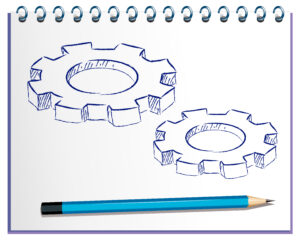Gearbox Noise & Vibration: Causes, Measurement & Control
Gearbox Noise and Vibration Measurement and Analysis Understanding Gearbox Noise and Vibration Mechanisms Gearbox noise and vibration remain pressing challenges in today’s industrial and automotive design processes. Engineers worldwide constantly seek ways to refine performance and minimize audible disturbances from gear systems. While high-precision gear manufacturing has significantly improved, gearbox NVH (Noise, Vibration, and Harshness) […]

Gearbox Noise and Vibration Measurement and Analysis
Understanding Gearbox Noise and Vibration Mechanisms

Gearbox noise and vibration remain pressing challenges in today’s industrial and automotive design processes. Engineers worldwide constantly seek ways to refine performance and minimize audible disturbances from gear systems.
While high-precision gear manufacturing has significantly improved, gearbox NVH (Noise, Vibration, and Harshness) continues to reveal itself as a complex, multi-factor problem. This complexity demands a deep understanding of root causes, advanced measurement technologies, and smart design strategies that all work together.
Noise and vibration often act as indicators of gear mesh issues, wear, or misalignment. Engineers know that small inefficiencies or imbalances can create significant acoustic outputs. In this context, noise is not merely a sound problem but a performance, reliability, and comfort concern.
A structured analysis of these parameters ensures gearboxes not only meet functional expectations but also deliver smooth, quiet operations demanded by modern applications.
Root Causes of Noise and Vibration in Gear Systems
The emergence of noise and vibration in Gear Design originates from the fundamental dynamics of gear meshing. As gear teeth engage, they generate excitation forces that propagate through the housing and surrounding structures.
Even slight deviations in gear tooth profiles or alignment cause significant variations in these forces, leading to both structure-borne and airborne noise. These deviations arise from common faults like surface roughness, pitch error, eccentricity, and runout.
Additionally, misalignment due to improper shaft mounting or bearing failure further compounds the problem. All these factors contribute to mechanical resonance or tonal noise that may occur across varying speed and load conditions.
Gear Geometry and Transmission Error Explained
Transmission error (TE) is arguably the most crucial factor affecting gear noise. TE occurs when the driven gear fails to match the theoretical rotation expected based on the input gear’s motion. This mismatch results from elastic deformation, gear tooth contact variation, or manufacturing defects.
TE gives rise to periodic excitation forces, which, in turn, manifest as tonal noise or gear whine. Engineers mitigate TE by refining gear geometry through crowning, tip relief, and lead correction. These profile modifications help distribute contact stress evenly, reducing the impact of TE. Consequently, noise levels drop and gearbox durability increases.
Measurement Techniques in Noise and Vibration Analysis
A comprehensive approach to vibration measurement is indispensable for diagnosing gearbox issues. Tools such as accelerometers, microphones, and laser Doppler vibrometers are widely used to capture vibration signals.
The data is then processed through FFT analyzers, which decompose it into frequency spectra. This makes it easier to identify dominant frequencies and resonance peaks associated with gear faults. These measurements are not limited to lab environments. In production and operational settings, condition monitoring systems use these tools for predictive maintenance.
Additionally, comparing baseline frequency responses with real-time data helps track changes in gearbox health.
Modal Analysis and Dynamic Behavior in Gear Systems
To prevent resonant conditions, engineers use modal analysis—a process that uncovers the dynamic properties of gear systems. Each mechanical component possesses natural frequencies and corresponding mode shapes. If operational vibrations match these natural frequencies, it leads to resonance, dramatically increasing noise.
Finite Element Analysis (FEA) simulates these dynamic behaviors under different conditions. With it, designers adjust system stiffness, mass distribution, or damping ratios to move natural frequencies away from operating ranges. Modal testing, supported by simulation data, ensures effective NVH control from design through deployment.
Rattle vs. Whine: Understanding Gear Noise Types
Gear noise can be broadly classified into rattle and whine. Rattle noise, often heard during idling or gear shifting, is caused by gear teeth losing contact and colliding due to backlash or looseness. These low-frequencies, impulsive sounds are irregular and primarily occur under low torque conditions.
Whine, by contrast, is a high-frequency tonal noise that becomes apparent under steady load. It is closely linked to transmission error and mesh frequency. While rattle can be reduced by applying preload or installing dampers, controlling whine demands precision engineering and tight manufacturing tolerances.
Optimizing Gear Design for NVH Reduction
Minimizing gearbox NVH starts with effective gear design. Choosing materials with better damping properties, refining gear surface finish, and incorporating profile corrections all play pivotal roles. Simulation-driven design processes help engineers test and validate improvements before manufacturing begins.
Multi-body dynamics simulations, for example, consider entire drivetrain interactions. Coupled with modal and harmonic analysis, they guide decisions on gear dimensions, microgeometry, and assembly tolerances. As a result, NVH performance improves without compromising durability.
Gearbox Vibration Monitoring and Diagnostic Insights
Modern manufacturing trends lean toward intelligent systems that monitor gearbox health continuously. Vibration monitoring devices embedded within gearboxes offer real-time insights. These smart sensors transmit data for analysis, triggering alerts before failures occur.
Such predictive diagnostics support just-in-time maintenance, eliminating the need for routine disassembly. This reduces operational costs and maximizes uptime. Additionally, coupling these systems with machine learning algorithms allows for accurate fault classification, further improving operational efficiency.
Keyword Applications and Summary
Integrating concepts like modal analysis, vibration measurement, transmission error control, and smart design ensures better gearbox performance. These practices reduce not only audible disturbances but also mechanical stress and operational fatigue. Leveraging in-process diagnostics and sensor-based monitoring systems creates a feedback loop that continuously improves NVH behavior.
By focusing on holistic gearbox design, real-time monitoring, and predictive maintenance, industries achieve smoother, quieter, and longer-lasting gear systems.
Managing gearbox noise and vibration requires more than patchwork fixes; it demands a system-level strategy. From reducing transmission error through precision gear geometry to deploying advanced measurement systems and conducting modal analysis, each step plays a role. Together, these actions lead to gearboxes that are not only quieter but also more reliable and durable—meeting the rising standards of today’s high-performance machinery.

